The individual makers of the Stielhandgranate
24 and 43
The production of the Stielhandgranate 24 was
initially handled by the company of Richard Rinker, but with the ever
increasing needs of the Reichswehr
in the prewar years their production capacities was not enough. The
introduction of new makers started already in the mid 1930's. Some
makers manufactured the Stielhandgranate until the end of the Reich,
while others changed to other products during the war or were bombed to
oblivion and discontinued their production.
Matching or not matching!? I have found no proof that would suggest
that any of the manufacturers actually made only
the handle or only the can. But it is a well-known
fact that most Stielhandgranaten
24 in "circulation" today are
mismatched, with different maker marks on the head and can. As the
Stielhandgranate 24 was strictly manufactured according to blueprints
approved by the Wehrmacht Waffen
Amt so the
components had the same dimensions and were made according to the DIN (Deutsches Institut für
Normung)
standards. So the threads on cans and handles would be identical
between the manufacturers, and the parts could be interchanged with no
problem. But why so many of them ended up mismatched is a mystery.

The different types of "ЯR", referred to as ЯR type 1-5.
As discussed on the page Richard Rinker and the "ЯR"
mystery, all early
(pre 1940) Stielhandgranate 24 were marked with the letters "ЯR" to
fool the Allies. In the picture above the company logo of Richard
Rinker is "Type 1", represented with an early and late version. "Type
2" is an attempt to copy the original logo used by other manufacturers.
"Type 3" has a reversed standard "R" that is linked at the middle with
a standard "R" and could be described as a half-hearted attempt to copy
the logo. "Type 4" has simply mirrored the first "R", followed with a
standard "R". "Type 5" consists of two simple "R". By studying the use
of the different types of logos it appears that most makers start
production with the simple type 4 or 5, but changed to the type 2 by
1940.
This compilation is in no way complete, and will continue to be updated
as new specimens are observed and new information can be found. It is
sorted alphabetically according to the three-letter code assigned to
each manufacturer. If no three-letter code was ever issued the maker is
listed at the bottom. I have added the years of manufacture that I have
observed, but this list is in no way complete. Please note that even if
a company delivered an item to the Wehrmacht in 1941, and then again in
1943, it isn't proven that they in fact made the same item in 1942.
Army contracts were drawn up for certain number of items, and
production could switch to other items in between. But if a 1938 dated
can made by one maker exists, it stands to reason that a 1938 dated
handle from the same manufacturer should also exist. I have chosen to
include only the markings I have observed myself, on originals or
through photos.
To complicate things further, some of the makers also manufactured
smoke handgrenades. In 1939 and the first half of 1940 the
handle for the Nebelhandgranate
was identical to the Stielhandgranate 24. For this reason it is hard to
tell if a single handle dated 39/40 was in fact made for a Nebelhandgranate or a
Stielhandgranate.
Most of the pictures used here have been copied from all over the
internet over several years. Due to this I am unable to credit the
pictures to each individual.
In the following text each maker is described with both the
three-letter code and early ЯR code if applicable. Some makers only
marked their products with one of the two. Codes that have
never been observed on a Stielhandgranate 24 & 43 have a light
yellow background, a small star is used to denote "unknown". WaA's
with no safe observation has been marked the same way.
A tabular of
known makers
|
Code
|
Early code
|
WaA
|
Company name
|
|
aqj
|
ЯR 789
|
WaA80
WaA291
|
S.
Elster, Gassmesser- u.
Gasapparatefabrik, Wien 101/XV, Felberstrasse
80.
|
|
arl
|
ЯR 90
|
WaA244
|
Bergmann
Elektrizitätswerke AG, Berlin Wilhelmsruhe
|
|
bdb.
|
ЯR 784
|
WaA198
|
A.
Grothe & Söhne GmbH Elektrotechnische Fabrik,
Köln-Zollstock
|
|
bdp.
|
ЯR 791
|
WaA136
|
Friedrich
Maurer Söhne, Eisenwerk und Kesselschmiede, München / Freimann
|
|
brb
|
ЯR
|
WaA65
|
Richard
Rinker GmbH,
Menden, Kreis Iserlohn
|
|
brc
|
FW
& Co (logo)
|
WaA847
|
Fritz
Weber & Co. Metallwaren- und Laternenfabrik, Berlin.
|
| can |
P 287 |
*
|
August Wallmeyer, Maschinenfabrik u.
Eisengiesserei, Eisenach |
| cap |
AV (logo) |
*
|
Adolf Völker, Zangenfabrik. Schmalkalden |
| cud |
ЯR 804 |
WaA648 |
Wilhelm Pfeiffer & Co.,
Metallbesteck-Fabrik, Solingen |
|
dbk
|
ЯR
|
WaA560
|
Richard
Rinker GmbH,
Neubrandenburg in Mecklenburg
|
|
dol
|
ЯR 802
|
WaA200
|
Domininghaus, Heinr.
Fabrik f. Baubeschlage, Brügge/Westfalen
|
|
dwx
|
ЯR 217
|
WaA331
WaA744
|
Schmöle
& Comp. Werk Immelborn,
bei Bad Salzungen
|
|
evy
|
ЯR 564
|
WaA832
WaA562
|
Wilhelm
von Hagen Metallwarenfabrik, Iserlohn Westfalen
|
|
eyu
|
ЯR 710
|
WaA703
|
Carl
Winzerling
K.G, Schloßfabrik. Volmarstein a.d. Ruhr
|
|
eyw
|
ЯR 803
|
WaA
A5
|
Georg
Brandstätter, Metallwaren- und Spezialfabrik. Zirndorf bei Nürnberg
|
|
fcc
|
*
|
WaA702
|
Metallwarenfabrik
Hermann Nier, Beierfeld bei Schwarzenberg,
Erzgebirge
|
|
flf
|
ЯR 513
|
WaA594
|
Vossloh-Werke
GmbH, Werdohl/Westfalen
|
|
ftd
|
ЯR 796
|
WaA555
|
Peter
Schlesinger, Metallwarenfabrik, Offenbach a.M.
|
| fzl |
ЯR 512 |
WaA587 |
Hermann
Wuppermann AG, Stanz- u. Emaillierwerk, Pinneberg, Hamburg |
|
gck
|
ЯR 517
|
WaA480
|
Metallwarenfabrik
Siegwerk
Gebrüder Schuppener,
Siegen Westfalen
|
|
ghs
|
ЯR 790
|
WaA141
|
Otto
l. Schmidt, Ingenieur. Berlin Hohenschönhausen, Quitzowstr
14.
|
|
gnx
|
ЯR 801
|
WaA73
WaA37
|
Nirona-Werke, Nier & Ehmer, Auto- und
Fahrradzubehör, Beierfeld/Erzgebirge
|
|
gzo
|
*
|
*
|
Autoflug,
Gerhard Sedlmayr, Werk Bernau, bei Berlin
|
|
gzq
|
ЯR 805
|
*
|
Kortenbach & Rauh
K.G. Solingen-Weyer
|
| jaj |
ЯR 798 |
* |
Fahrrad- u. Metallwerke L. Bauer & Co
Klein Auheim, Hanau/Main |
|
jvf
|
*
|
WaA41 WaA204
|
Wilhelm
Brand, Treibriemenfabrik. Heidelberg, Eppelheimerstr.
40.
|
|
wc
|
ЯR 797
|
WaA698
|
Hasag,
Hugo Schneider AG, Metalwarenfabrik
Leipzig, Werk Meuselwitz,
Thuringia
|
|
*
|
ЯR 510
|
WaA582
|
Galler, Hamburg-Altona
|
|
*
|
358-A-031 |
WaA83 |
Unidentified |
Let's get down to business and see what we have got!
aqj
aqj
was the code assigned to S. Elster,
Gassmesser- u. Gasapparatefabrik, Wien 101/XV, Felberstrasse 80.
The company was founded in 1891 in Vienna by Johannes Siegmar Elster
and Conrad Elster. It
manufactured and repaired gas meters, gas cookers, heating and lighting
equipment. Later it expanded into electric motors and electrical
equipment. The company is still in operation.
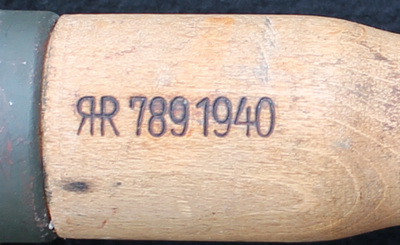
Early code ЯR 789. ЯR type 3.
Only observed on 1940 dated handles. Possibly only made for the smoke
grenade.

Code observed on can: aqj
1943 and aqj 1944
Code observed on handle: ЯR aqj 1941
and aqj 44
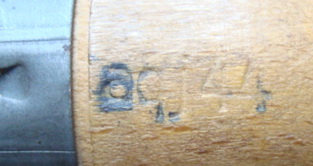
Code observed on Stielhandgranate 43 can: No observation
Code observed on Stielhandgranate 43 handle: aqj 44
WaA appears to be WaA80 and WaA291,
but no safe observation yet.
arl
arl
was the code assigned to Bergmann Elektrizitätswerke AG, Berlin Wilhelmsruhe
Founded in 1891 in Berlin-Moabit
as Sigmund Bergmann & Co. OHG. They manufactured
electric lighting and telephone systems. In 1893 the company
changed its name to Bergmann Elektrizitätwerke
Aktien-Gesellschaft.
In 1906 they relocated to Wilhelmsruhe.
In 1932 the production was focused on metal works, a cable plant,
machinery and an automobile factory. In 1933 Bergmann employed 900
people. By 1933/1934 parts of the work was gradually converted to
military production. Foreign forced laborers were used from 1940. Due
to the increasing bombing in 1943/1944 the company relocated part of
its military production to Ratibor
in Upper Silesia. On April 23, 1945, the Red Army occupied the Wilhelmsruhe Werk.
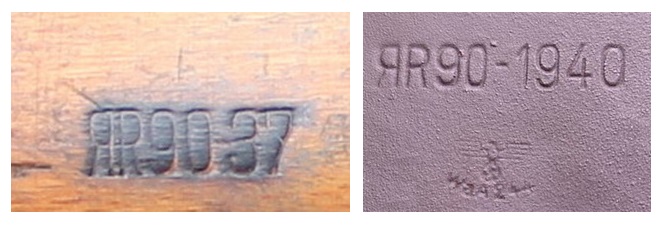
Early code observed on can: ЯR
90-1939 and ЯR
90-1940. ЯR type 4.
Early code observed on handle: ЯR 90-36, ЯR 90-37 and
ЯR
90/1940. ЯR type 3.
Three-letter code never observed on can or handle, which would indicate
that they didn't manufacture Stielhandgranaten
24 after 1940, but must have used their production capacity to
manufacture other products.
Heereswaffenamt
code WaA244.
bdb
bdb
was the code assigned to A. Grothe
& Söhne GmbH Elektrotechnische Fabrik, Köln-Zollstock
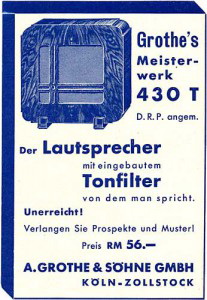
The factory was located at Höninger
strasse
147-155 and was run by the founder's sons. They manufactured
loudspeakers with wooden cabinets before the war. In 1943 the
working force consisted of 50 Ukrainians in addition to the German
supervisors. The factory was badly damaged due to a bombing attack on
17 June 1943, and went out of business when it was totally destroyed by
another attack on 29 June 1943.
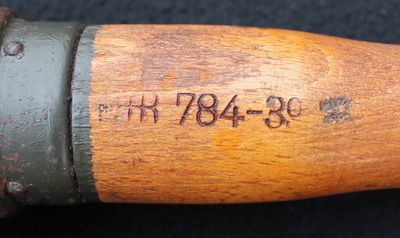
Early code observed on can: No observation
Early code observed
on handle: ЯR 784-39 ЯR type 3 and ЯR 784-40
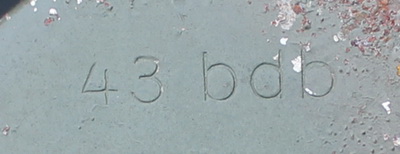
Code observed on can: 43 bdb
Code observed on handle:
42 bdb, 43 bdb and 44 bdb
Heereswaffenamt
code appears to be WaA198.
bdp.
bdp.
was the code assigned
to Friedrich Maurer Söhne, Eisenwerk und Kesselschmiede,
München-Freimann.
Founded in 1876 by Friedrich Maurer in Munich
they initially manufactured steel constructions like bridges, hangars
and steel doors. The company is still in operation, manufacturing,
among other things, roller coasters.

Early code observed on can: ЯR 791 1940. ЯR type 3.
Early code observed on handle: ЯR 791 1940. ЯR type 3
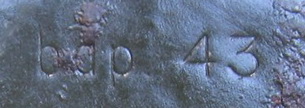
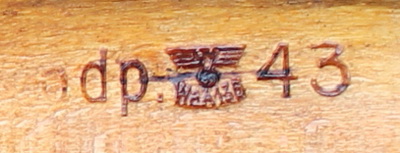
Code observed on can: bdp.
43 and bdp 4
Code observed on handle: bdp.
42, bdp. 43 and bdp. 44
Of special note: The code was followed by a
punctuation to avoid confusion if it was turned upside down. The code
used on the handle was stamped the opposite way of most other makers,
running bottom-up. This makes the first letter fall on the curved area,
almost always weakly impressed. In addition the WaA was placed between
the code and the year on the 43 and 44 dated handles, unlike all other
makers.

Code observed on Stielhandgranate 43 can: bdp. 44 and bdp. 4,
Code observed on Stielhandgranate 43 handle: bdp. 44 and bdp. 45
Heereswaffenamt
code WaA136.
brb

brb was the code assigned to Richard Rinker GmbH,
Menden, Kreis Iserlohn.
Richard Rinker GmbH was founded in
1910, and was situated in Menden in Iserlohn. It specialized in the
production of castings, especially of building hardware made of brass.
In the mid-1930s the production was switched to light metals. They were
still in production in 1991, manufacturing heaters under the name BAUFA-Werke Richard Rinker
GMBH.
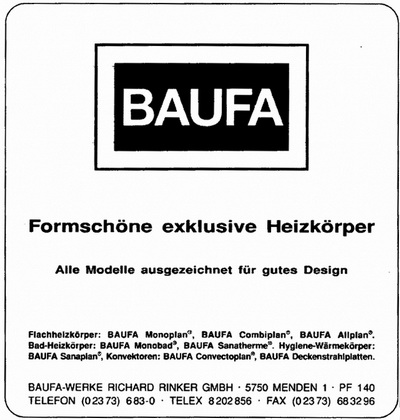
More details about the company can
be found on the Stielhandgranate 24
main page.

Early code observed on can: ЯR
1936, ЯR 1937, ЯR 1938, ЯR 1939, ЯR 1940 and ЯR 1941. ЯR type 1.
Early code observed on handle: ЯRB, ЯR 1936, ЯR 1937. ЯR 1939
and ЯR 1941. ЯR type 1.
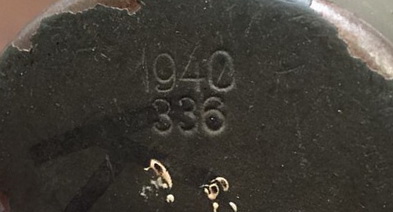
As an intermediate measure they chose to code their products
with their assigned code "336"in the second half of 1940. The three-letter code brb was fully
introduced by the start of 1941. "ЯR 1941" marked Stielhandgranaten 24 were marked
with the makers old logo for export reasons.

Code observed on can: 41 brb, 42
brb, 43 brb and 44 brb.
Code observed on handle: 41 brb, 43 brb and 44 brb.

From 1925 to 1935 all years of manufacture were to be coded, using a
capital letter. This code can be observed on Richard Rinker made
products predating 1936. The above handles for Übungshandgranaten
(the ones most likely to survive!) were made by Richard Rinker and
dated "M" for 1927 and "G" for 1935. This code system has not been
observed in use by any other maker of the Stielhandgranate 24, most
probably because Richard Rinker was the only manufacturer up to 1935.

Code observed on Stielhandgranate 43 can: 44 brb
Code observed on Stielhandgranate 43 handle: 44 brb
Heereswaffenamt
code WaA65.
brc
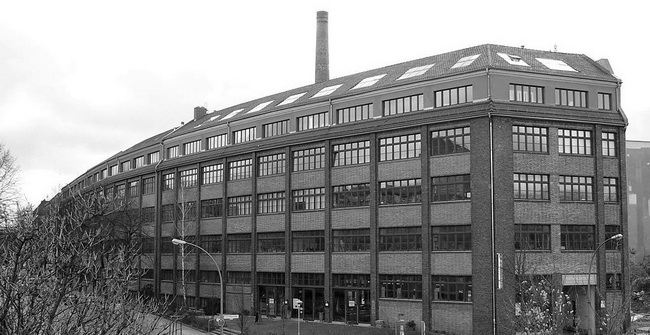
brc
was the code assigned to Fritz Weber & Co. Metallwaren- und Laternenfabrik, Berlin.
The building pictured above was part of the original factory complex,
but was rebuilt and restored postwar and this is the current look.
The company was founded by Fritz Weber, who had a key position as an
economic leader within the Wehrkreis
(army district). He was also a member of the NSDAP. Between 1935 and
1940 he built a new factory complex at the corner of Kiefholz- and Lohmühlenstraße in Berlin. The
factory made equipment for the Wehrmacht. Among the products were MG34
ammo cans, barrel carriers and other ammunition containers. The company
employed 2300 persons in the prewar years. These were gradually
replaced by "Ostarbeiter",
workers imported from the occupied territories. The factory complex was
damaged by US bombers on 21. June 1944 and again on 3. February 1945.
The frontline reached the factory complex with street fights 26. April
1945, and all production stopped. Postwar the factory was rebuilt and
incorporated in the East German VEB Berliner Werkzeugmaschinenfabrik.
The manufacture of Stielhandgranaten
24 must have been a small sidestep in 1938-1940, as surviving examples
with this logo are very scarce.

(Picture
courtesy of Tighe, USA)
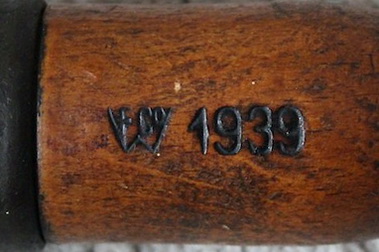

(Picture courtesy
of ROS, Russland)
Code observed
on can: No marking applied to the metal
Code observed on handle: Factory logo, F W Co 1938, F W Co 1939 and F W Co 1940.
Of special note: The Stielhandgranate 24 manufactured by
Fritz Weber & Co stands out in several aspects. The can is
unmarked (in regards to the makers mark punched into the metal on top),
but has a text that has been applied with a stencil, instead of the
normal roller stamp. The handle has a factory logo instead of the code
applied by most other makers.
Heereswaffenamt
code WaA847.
can
can
was the code assigned to August Wallmeyer, Maschinenfabrik u.
Eisengiesserei, Eisenach.
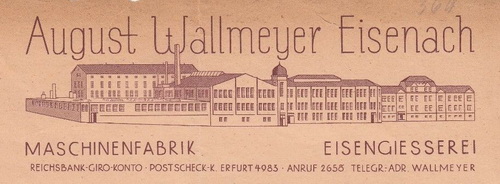
This
manufacturer was involved in the production of ammunition in the times
leading up to WW2, and was issued the code P287.
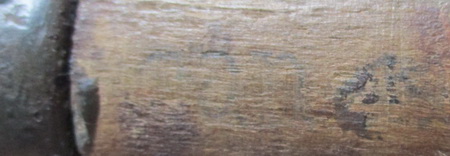
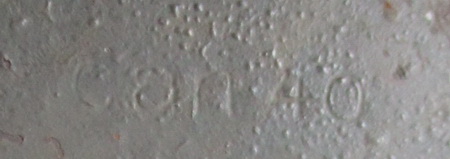
(Pictures
courtesy of Ростислав, Russia)
Up to now,
there has only been one observation of this maker. Both can and handle
is marked "can 40". With only one observation it is unclear if
the
marking is a misprint by a manufacturer or if it is in fact the only
known survivor. This grenade surfaced in
Russia, which might explain where all the rest of them disappeared....
cap
cap
was the code assigned to Adolf Völker,
Zangenfabrik. Schmalkalden. This company
manufactured tools in the prewar era and delivered daggers to the SA
and NSKK in the late 1930's / early 1940's.
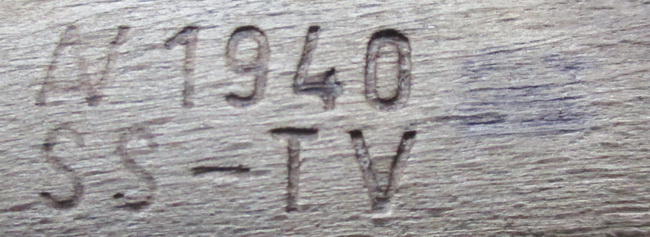
(Picture
courtesy of Ростислав, Russia)
Early code
observed on can: No observation
Early code observed on handle: AV logo 1940 SS-TV (Note the
use of standard font "SS")

Code observed on can: No observation
Code observed on handle: cap 41 SS-TV, cap 42
Of special note: These Stielhandgranate 24 were manufactured especially
for the Waffen-SS, and they are marked SS-TV, an abbreviation for SS-Totenkopfverbände. Due to the
internal competition between the armed forces the newly formed Waffen SS formations had to
equip themselves with whatever weapons they could get hold of. This
included both the use of weapons from the occupied countries, as well
as weapons procured from German and foreign factories that didn't have
a contract with the Wehrmacht. Incidentally, some of these handles have
turned up at the same locations that the first SS-TV units were
deployed in the spring of 1941. The ones marked cap 42 are most
probably from a standard Wehrmacht contract. The handle on
the 1940 production has a factory logo instead of the code
applied by most other makers.
Heereswaffenamt
code has not been decrypted.
cud
cud
was the code assigned to Wilhelm Pfeiffer & Co.,
Metallbesteck-Fabrik, Solingen.
This company
manufactured cutlery prewar, during the war and postwar.

The
cutlery was marked with their trademark of two persons
sitting back to back (smoking pipes?) and the trademark name
"Mangasil". During the war years they manufactured both
Nebelhandgranate 39 B (can and handle) in 1941 and Stielhandgranate 24
in 1943.

(Picture courtesy of Miguel at ersatzmilitaria.com)
Code observed
on can: cud/43
Code observed on handle: cud 1943
Heereswaffenamt
code WaA648.
dbk
dbk
was the code assigned to Richard Rinker GmbH, Neubrandenburg
in Mecklenburg.
Neubrandenburg was a quiet little town with about 15 000 inhabitants
until the Nazis came to power. From 1933 the military industry played a
vital role. The company of Richard Rinker was a wood processing
company, manufacturing ammunition boxes and handgrenades with the use
of forced laborers from the Ravensbrück
concentration camps. The manufacturing plant had up to 6000 workers.
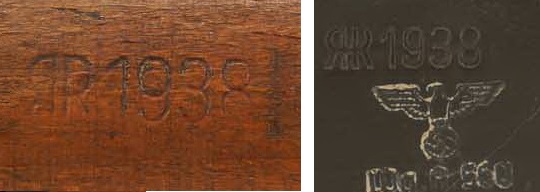
Early code observed on can: ЯR 1938 and ЯR1940. ЯR type 1.
Early code observed on handle: ЯR 1938, ЯR 1939 and ЯR 1940.
ЯR type 1.

Code observed on can: dbk
41, 42 dbk and 43 dbk
Code observed on handle: dbk
41, 42 dbk, 43 dbk and 4 dbk
Of special note: In 1941 the code is followed by the year. In 1942 this
has been reversed.
Heereswaffenamt
code WaA560.
dol
dol was the code
assigned to Domininghaus, Heinr.
Fabrik f. Baubeschlage, Brügge/Westfalen.

The company was founded in 1862 by
Heinrich Domininghaus.
By the turn of the century it employed 100 workers. Their prewar
production included hardware for windows, ironmongery, wire
products and meat
hooks. The company is still in operation.
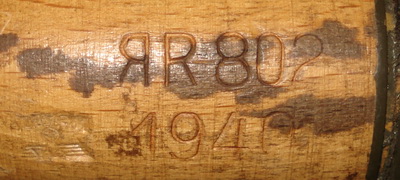
Early code observed on can: no observation
Early code observed on handle: ЯR-802
1940. ЯR type 4.
Only observed on smoke grenade handles (with grooves)!
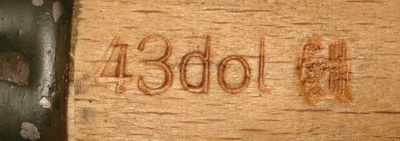
Code observed on can: no observation
Code observed on handle: 42 dol
and 43 dol
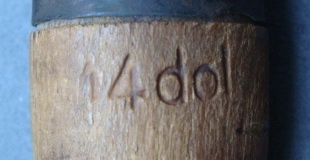
Code observed on Stielhandgranate 43 can: No observation
Code observed on Stielhandgranate 43 handle: 44 dol
Heereswaffenamt
code appears to be WaA200.
dwx
dwx
was the code assigned to Schmöle
& Comp. Werk Immelborn, bei Bad Salzungen.
The company was founded in 1853 by Carl Schmöle.
It received its first orders for military material already in
1887 as a result of the reorganization of the German army. Schmöle & Co also
manufactured the Drückzünder
35 and other igniters. The early code of ЯR217 was by far the hardest
code to crack, as it is missing from the 1939 dated code-list that all
later literature has been based upon. In the end it was the markings on
boxes of DZ35 that enabled the positive verification of the early code.
The company went out of business in 2002.

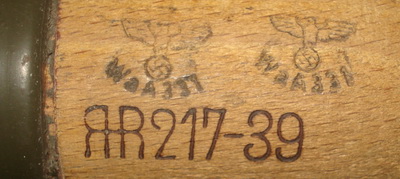
Early code observed on can: ЯR 217-1937, ЯR 217-1938, ЯR
217-1939 and ЯR 217-1940. ЯR type 3.
Early code observed
on handle: ЯR 217-38, ЯR 217-39 and ЯR
217-1940. ЯR type 3.
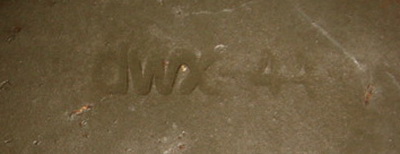
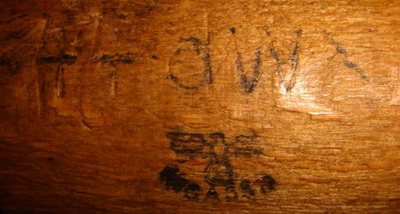
Code observed on can: dwx
- 44
Code observed on handle: dwx - 41 and 44 - dwx
Of special note: The code and year is reversed from the can to the
handle on the later production.
Heereswaffenamt
code WaA744 and WaA331.
evy
evy
was the code assigned to Wilhelm von Hagen Metallwarenfabrik, Iserlohn Westfalen.

The following text is from a prewar company index. "Wwe.
Wilh. von Hagen,
Iserlohn. Metallwarenfabrik.
Telephone number 1751 and 1752. With over 300 workers and employees,
the factory manufactures its specialties in fittings for interior
decoration, for ovens and stoves and for iron furniture. It distributes
its products in direct exports to all markets of the world."
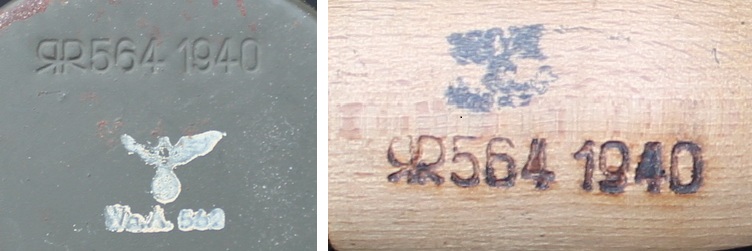
Early code observed on can: ЯR 564 1938, ЯR 564 1939 and ЯR 564 1940.
ЯR type 5 and type 2.
Early code observed on handle: ЯR 564 1938, ЯR 564 1939 and ЯR 564
1940. ЯR type 5 and type 2.

Code observed on can: 42 evy
and 43 evy
Code observed on handle: 42 evy
and 43 evy
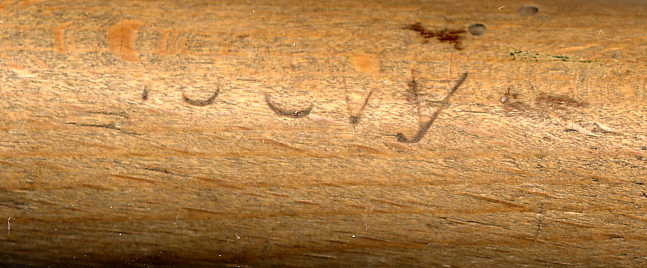
Code observed on Stielhandgranate 43 can: No observation so far
Code observed on Stielhandgranate 43
handle: 45 evy
Of special note: In 1938 and 1939 this maker marked its products with
the simple RR style 5, but changed to the more correct ЯR style 2 in
1940.
Heereswaffenamt code WaA832
and WaA562.
eyu
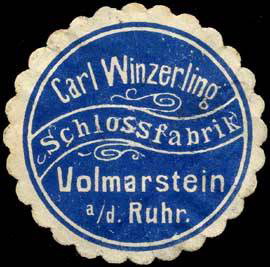
eyu
was the code assigned to Carl Winzerling
K.G, Schloßfabrik. Volmarstein a.d. Ruhr.
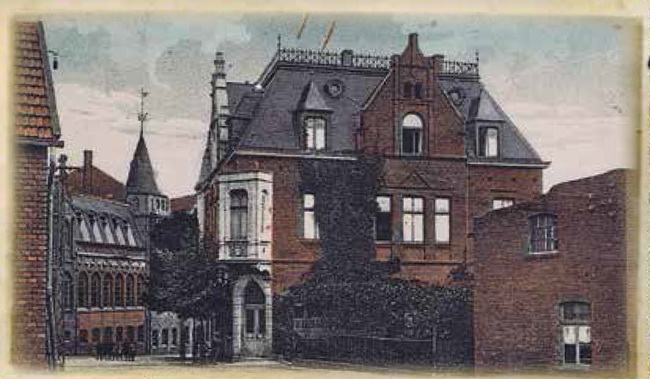
On this old postcard of the Gaststätte
(Guesthouse) Schackmann,
the lock factory of Carl Winzerling
can be seen on the left in the picture. It was situated right in the
middle of the small city of Volmarstein.
The building was torn down in 1974.
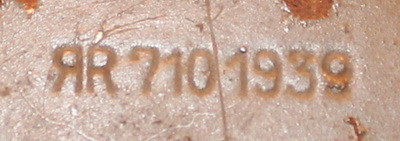
Early code observed on can: ЯR 710 1939 and ЯR 710
1940. ЯR type 4.
Early code observed on handle: ЯR 710 1940. ЯR type 4.

Code observed on can: 43 eyu
and 44 eyu
Code observed on handle: 44 eyu
Of special note: The font used for the year 1943 on the can is
considerably larger than the font used for the code.
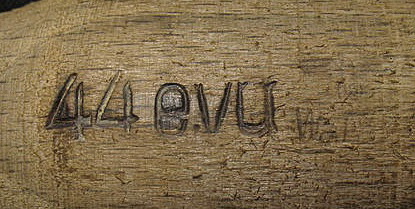
Code observed on Stielhandgranate 43 can: No observation
Code observed on Stielhandgranate 43 handle: 44eyu
Heereswaffenamt
code WaA703.
eyw
eyw was the
code assigned to Georg Brandstätter,
Metallwaren- und Spezialfabrik. Zirndorf bei Nürnberg.
Georg Brandstätter
took over the family company from his father in 1908 and renamed it Metallwarenfabrik Georg Brandstätter. They manufactured
toys, telephones and piggy banks. Post WW2 they continued their
civilian production lines with toys being their main product. This
company is today the manufacturer of the Playmobil
plastic figures series.
I have only found handles marked with their early code, ЯR
803, dated 1940. It is impossible to tell if these were made for the
smoke handgrenade or the Stielhandgranate 24.

Early code observed on can: No observation
Early code observed on handle: ЯR 803 1940 and ЯR 803/1940. ЯR type 4.
Of special note: The 1940 dated handle comes in two varieties of
marking, with and without the slash. This might
indicate that ЯR 803 manufactured both a Stielhandgranate 24 and a Nebelhandgranate 39 in 1940.
Heereswaffenamt
code WaA A5.
fcc
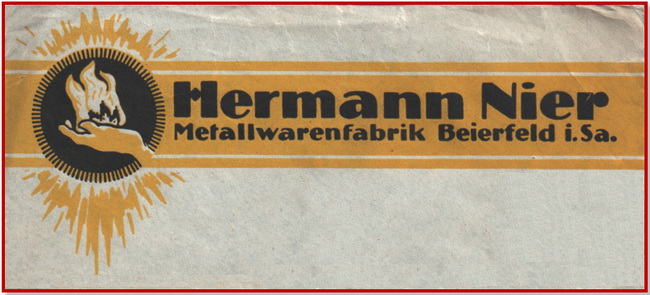
fcc
was the code assigned to Metallwarenfabrik
Hermann Nier, Beierfeld bei Schwarzenberg, Erzgebirge
The Metallwarenfabrik
Hermann Nier, Beierfeld bei Schwarzenberg was founded by
Ernst and Hermann Nier.
They started to manufacture lanterns by hand in Beierfeld
in the Erzgebirge in 1880. A few years later the production was changed
to mechanical manufacture of storm lanterns. During WW1 they
manufactured Stielhandgranaten
15 and steel helmets.
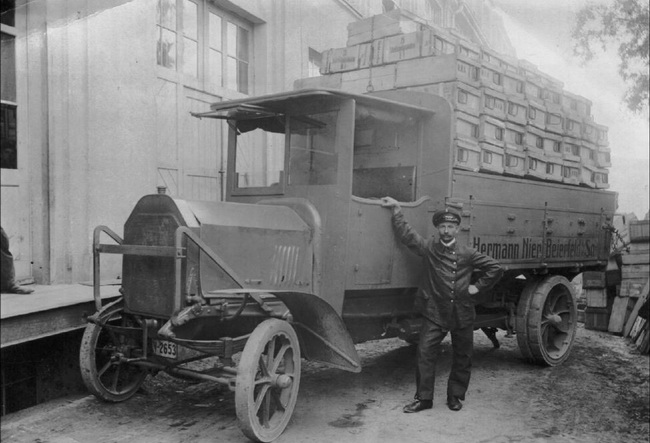
The LKW above is loaded with crates that would contain Stielhandgranaten 15. Note the
company name on the side of the truck.
In 1937 the number of lanterns sold amounted to around 12 million
units. By 1941 they were one of the bigger manufacturers of the FE41
and later FE42 gas mask filters, a production that continued to 1944.
The production of lanterns was ended in 1943 and replaced
by ammunition parts, especially Stielhandgranate 24 and 43,
but they also manufactured parts for the V-1 and V-2. Metallwarenfabrik Hermann Nier was the only maker
that manufactured the third version (stamped threads) of the
Stielhandgranate 24 in numbers. The company was never assigned an early
code. By December 1944 the workforce was up to 1622 persons, including
65 forced laborers from the occupied territories in the east. They
worked 73 hours each week. After the end of World War II, the company
was expropriated and dismantled by the Soviet occupation force.

Code observed on can (second version): 43 fcc
Code observed on handle (second version): 43 fcc and fcc 43

Code observed on can (third version): 43 fcc
and 44 fcc
Code observed on handle (third version): 42 fcc, 43 fcc
and 4 fcc

Code observed on Stielhandgranate 43 can: 44 fcc
Code observed on Stielhandgranate 43 handle: No observation so
far
Heereswaffenamt code WaA702.
Of special note: fcc
was the only manufacturer of the Stielhandgranate 24 (third version)
that used the Dunkelgelb
(tan) color. They were also the only manufacturer that actually
manufactured the third version in numbers. The handles for the
Stielhandgranate 24 manufactured by fcc
has a coding system that hasn't been deciphered yet. All of them have a
symbol stamped into the wood, in addition to the normal year and code.
The symbols observed include a star, an arrow, a square, a triangle and
a circle.
flf
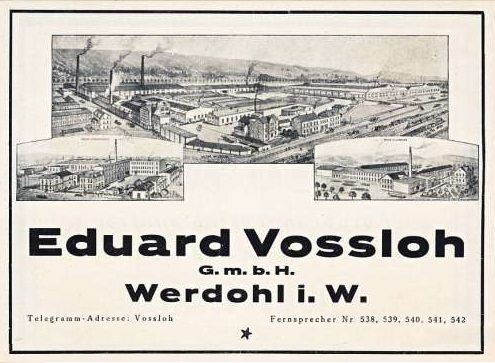
flf was the code
assigned to Vossloh-Werke
GmbH, Werdohl/Westfalen
The company was founded in 1888 by Eduard Vossloh,
a wounded war veteran and blacksmith. His children continued his work
when he died in 1899. By the start of WW1 the company had 250
employees. In the 1920's they expanded production to pipes, wires,
light bulbs and decoration goods in several production plants. But
their most important product was railway rail springs (the part that
holds the rails to the sleepers). In 1930 the whole structure was
centralized to the Vossloh-Werke
GmbH. During WW2 their war production included Stielhandgranaten
and boxes for explosives. Most of the buildings in the Werk Werdohl
were destroyed by the end of the war, and production came to a
standstill. But the factories were restarted in 1946 and the company is
still in business today, manufacturing railway equipment.
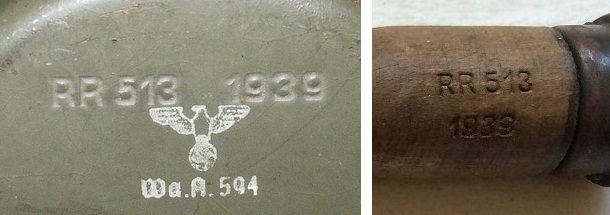
Early code observed on can: RR 513 1938, RR 513 1939
and RR 513 1940. RR type 5.
Early code observed on handle: RR 513 1938
and RR 513 1939. RR type 5.

Code observed on can: 42 flf,
43 flf and 44 flf
Code observed on handle: 42 flf, 43 flf
and 44 flf

Code observed on Stielhandgranate 43 can: flf 44
Code observed on Stielhandgranate 43 handle: 44 flf
Heereswaffenamt
code WaA594.
ftd
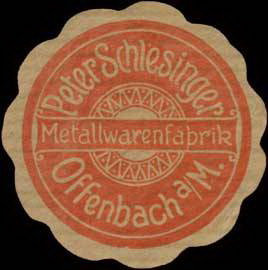
ftd was the code
assigned to Metallwarenfabrik
Peter Schlesinger, Offenbach a.M.
The company was founded by Peter Schlesinger (1859-1934) in 1885, and
made accessories and spare parts for the bicycle and automotive
industry. Their bicycle lights were sold under the brand "Radsonne" (bicycle sun). During
WW2 they manufactured cleaning kits for small arms (Reinigungsgerät 34), Smoke
handgrenades (Nebelhandgranaten),
Stielhandgranate 24 and Stielhandgranate 43.
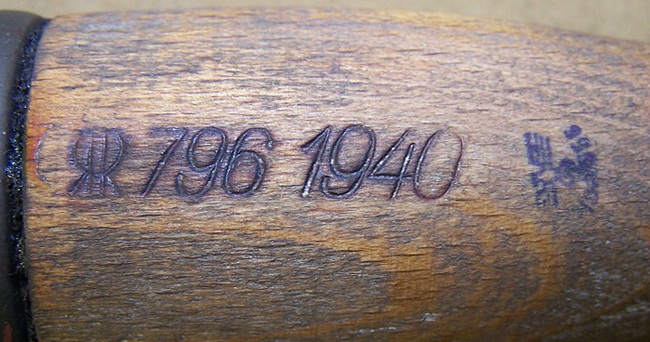
Early code observed on can: No observation
Early code observed on handle: ЯR 796 1940. ЯR type 2. (Possibly smoke
grenade handle).

Code observed on can: ftd
43
Code observed on handle: ftd 43
and ftd 44

(Unsure about the originality of this one, something strange with the
stamping)
Code observed on Stielhandgranate 43 can: no observation
Code observed on Stielhandgranate 43 handle: ftd 44
Heereswaffenamt
code: Appears to be WaA 555
fzl
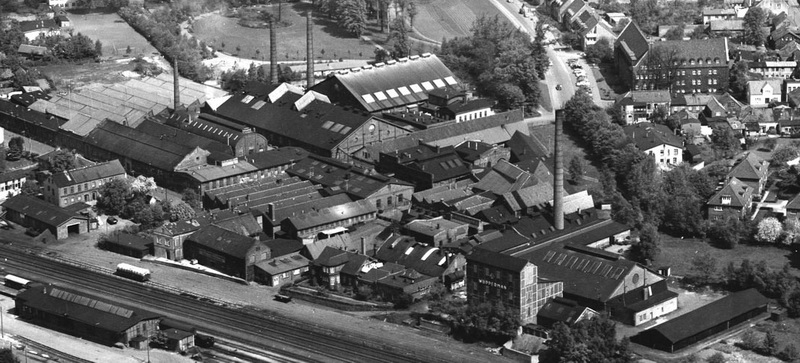
fzl was the code
assigned to Hermann Wuppermann
AG, Stanz- u. Emaillierwerk, Pinneberg, Hamburg.
Picture above was taken in 1962, the year the factory shut down.
The company was bought by Herman Wupperman
in 1878. He transformed it into one of the biggest enamel manufacturers
in Europe, 2/3 of the production for export. During WW1 they
manufactured mess kits, canteens, drinking cups, ammunition parts and
handgrenades. The interwar depression reduced the staff from 725
employees to 280. But the re-birth of the German army in 1935 filled
the order books again. They manufactured mess kits, canteens, mines,
igniters, ammunition boxes and parts for the Panzerfaust during the
war. Production of enamel products continued after the war, but with
fewer and fewer workers. The factory was closed in 1962.
The manufacture of Stielhandgranate 24 appears to have been limited to
the years 1938-39-40-41. Stielhandgranate 24 with the code fzl are very scarce.

Early code observed on can: RR 512 1938, ЯR 512 1939 and ЯR 512 1940.
RR type 5 and 4.
Early code observed on handle: ЯR 512 1939 and ЯR 512 1940. RR type 5
and 4.

Of special note: Two different 1939 dated handles have been observed
with two different ЯR styles. The same change has been observed with
other makers. The procurement officers of the Wehrmacht must have been
placing demands on the industry to improve their "ЯR camouflage", and
the RR type changes from Type 5 (normal RR) to Type 4 (with reversed
first letter).

(Picture
courtesy of ROS, Russland)
Late code observed on can: No observation yet.
Late code observed on handle: 41 fzl
Heereswaffenamt
code: Appears to be WaA 587
gck
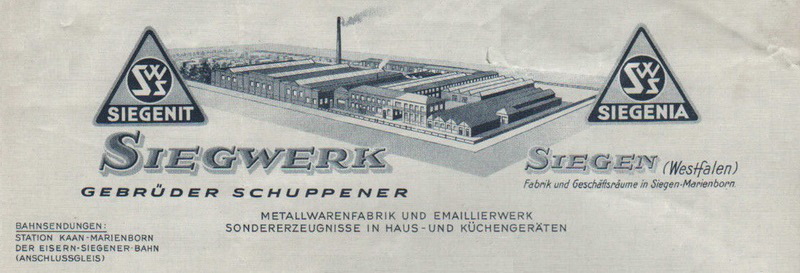
gck was the code
assigned to Metallwarenfabrik
Siegwerk Gebrüder Schuppener,
Siegen Westfalen
The company manufactured enamel and metal products in the prewar era,
specializing on kitchen utensils.

Early code observed on can: RR 517. 1938, RR 517.
1939 and RR 517. 1940. RR type 5.
Early code observed on handle: RR 517. 1938, RR 517. 1939
and RR 517. 1940. RR type 5.

Code observed on can: 41 gck,
42 gck, 43 gck and 44 gck
Code observed on handle: 41 gck, 42 gck,
43 gck and 44 gck

Code observed on Stielhandgranate 43 can: gck 44
Code observed on Stielhandgranate 43 handle: 4 gck
Heereswaffenamt code: WaA
480
Of special note: The code RR 517. was always followed by a punctuation.
ghs
ghs was the code
assigned to Otto l. Schmidt, Ingenieur.
Berlin Hohenschönhausen,
Quitzowstr 14. The
early code assigned to this manufacturer was ЯR790.
I am unable to find any more information. The
only observations made are handles marked ghs
1942

Code observed on can: No observation
Code observed on handle: ghs 1942, ghs 1943.
Heereswaffenamt
code appears to be WaA141.
gnx
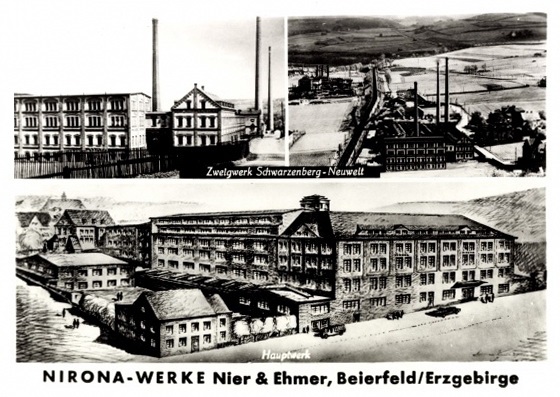
gnx was the code
assigned to Nirona-Werke,
Nier & Ehmer, Auto- und Fahrradzubehör, Beierfeld/Erzgebirge
The company was founded in 1905. Their line of products in the prewar
years included accessories for automobiles and bicycles, as well as
portable gramophones. During WW2 their main product was Jerry cans.

Early code observed on can: ЯR 801 1940. ЯR type 4.
Early code observed on handle: ЯR 801 1940. ЯR type 4.

Code observed on can: gnx
43
Code observed on handle: gnx
43 and gnx-44
Heereswaffenamt code WaA73 and WaA37.
Of special note: The early code used a hyphen between the code number
and year. The font used for the code "gnx"
on the can is considerably smaller than the date "43". The profile of
the handle marked gnx
43 is not identical to other versions of the Stielhandgranate 24
handle. The gnx 43
handle has a much longer wide part towards the raincap.
gzo
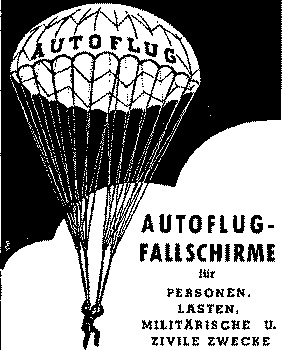
gzo was the code
assigned to Autoflug,
Gerhard Sedlmayr, Werk Bernau,
bei Berlin
„Spezialhaus für AUTOmobil
und FLUGwesen,
AUTOFLUG“ was founded by Gerhard Sedlmayr
in 1919 in Berlin-Johannisthal.
Gerhard Sedlmayr was
born in 1891. In the 1920's the company cooperated with Leslie Irvin
and introduced the modern parachute in Germany. This became the main
product, and they made large quantities for the Luftwaffe. Their WW2
production also included Nebelhandgranaten
and Stielhandgranaten
24. The factories in Berlin were totally destroyed during the second
half of the war. The company is still in business, manufacturing and
conducting maintenance on survival equipment for airplanes. The company
was never issued an early code.

Code observed on can: gzo
43
Code observed on handle: gzo.
1943, gzo.
1944
Of special note: Although I believe both specimens pictured above to be
real, the observant reader will note the differences between the
markings. On the handle the code is followed by a period, and the year
is written with four digits. On the can the period is missing and the
year is written with two digits.
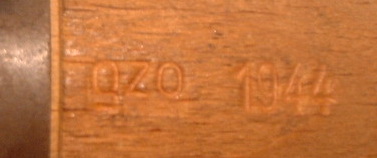
Code observed on Stielhandgranate 43 can: No
observation yet.
Code observed on Stielhandgranate 43 handle: gzo 1944
Heereswaffenamt code has not
been identified yet.
gzq
gzq was the code
assigned to Kortenbach
& Rauh K.G.
Solingen-Weyer.
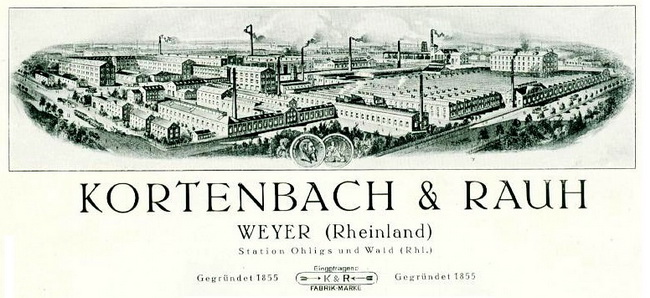
Kortenbach & Rauh K.G. was founded in 1855 in
Weyer, Solingen.
By 1914 the company employed 1200 workers and was one of the largest in
the Solingen area. Their main product was the self-opening umbrella
manufactured under the name "Kobold". During WW2 they employed between
100 and 200 forced laborers (Ostarbeiter)
Their WW2 product line is a mystery, as I have not managed to find any
documents or items marked with their codes. The only item found is a
1940 dated handle with their early code. So it could be either a
Stielhandgranate 24 or a Nebelhandgranate
39.
The company is still in business, manufacturing car parts.
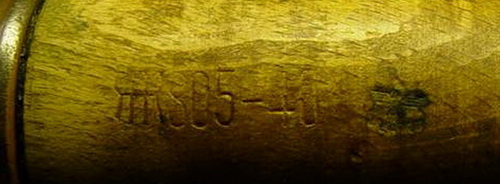
Early code observed on can: No observation
Early code observed on handle: ЯR 805-1940. ЯR type 3. (Possibly smoke
grenade handle).
Heereswaffenamt code has not
been identified yet.
jvf
jvf was the code
assigned to Wilhelm Brand, Treibriemenfabrik.
Heidelberg, Eppelheimerstr.
40. The company was in production during most of the war, manufacturing
all sorts of equipment for the Wehrmacht including flare gun ammunition
holsters, leather slings for the K98k, map cases, Luger holsters,
carriers for entrenching tools and leather equipment for horses.
I guess that they changed into manufacture of the Stielhandgranate 43
late in the war (1944-45) due to the loss of other companies that made
handgrenades.
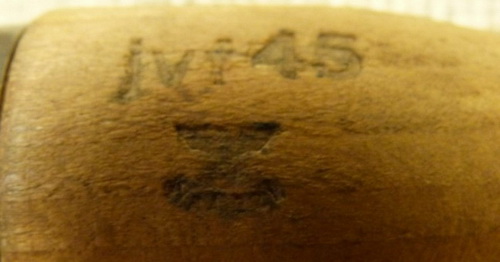
The code has only been observed on a Stielhandgranate 43 handle.
Heereswaffenamt
code WaA41 and WaA204.
wc
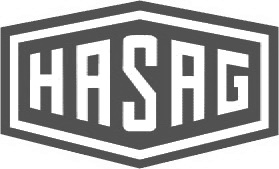
wc was the code
assigned to Hasag, Hugo
Schneider AG, Metalwarenfabrik
Leipzig, werk Meuselwitz, Thuringia.
Metallwarenfabrik
Hugo Schneider AG was founded in 1899. In the first years their main
products were metal lamps and cookers. With the Great war they changed
their production to ammunition components and other war materials. Post
WW1 they resumed production of their civilian products, until the
1930's again brought along the demand for military hardware. Their
production increased until they in 1939 were the largest "war effort
company" in Germany, which they remained until the end of the Reich.
The HASAG company manufactured belt drums and belt drum holders for
MG34 & 42, Panzerfausts, Panzerschrecks
and ammunition components. The production line once again changed to
civilian products after the end of the war. In 1947 all machinery and
useful assets were removed to the Soviet Union and the buildings were
blown up.

Early code observed on can: ЯR 797 1939 and ЯR 797 1940. ЯR
type 4.
Early code observed on handle: ЯR 797 1939 and ЯR 797 1940. ЯR type 4.

Code observed on can: wc
43 and wc 1944
Code observed on handle: wc 1942, wc
1943 and wc 1944

Code observed on Stielhandgranate 43 can: wc
1944, wc 45
Code observed on Stielhandgranate 43 handle: No observation so
far
Heereswaffenamt
code appears to be WaA 698
ЯR 510
ЯR 510 was the early code assigned to Galler, Hamburg-Altona. I am not
able to find any information about this company, and they were never
issued a three-letter code, so I guess production ended in 1940.
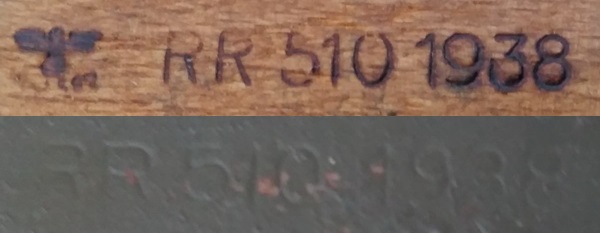

Early code observed on can: RR 510 1938, RR 510 1939
and ЯR 510 1940. ЯR
type 5 and 4.
Early code observed on handle: RR 510 1938, ЯR 510 1940.
ЯR type 5 and 4.
Heereswaffenamt code appears
to be WaA 582 or WaA
592
MSM
This maker was wrongly identified as a
Stielhandgranate 24 maker up to now. It has been moved to the
Nebelhandgranate section, as it in fact is a Nebelhandgranate
manufacturer.
358-A-031
The maker hidden behind the code 358-A-031 has
not been identified yet.
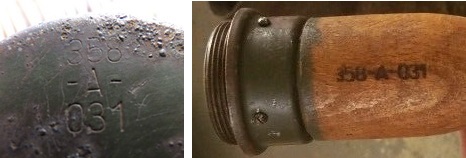
There are absolutely no clues to be found that can shed any light on
this special marking. The grenades are standard production.
Heereswaffenamt
code is WaA83
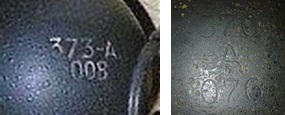
The same kind of marking has been observed on Eierhandgranaten
39, but the numbers are different.
One theory that has been launched is that these might be "foreign
markings". The Germans exported weapons to their allies, and these
might have been marked according to the recipients' wishes. The ones
that show up all appears to be from the eastern front, so they might
have been made for Hungary or Romania.


 Stielhandgranate
24
Stielhandgranate
24 